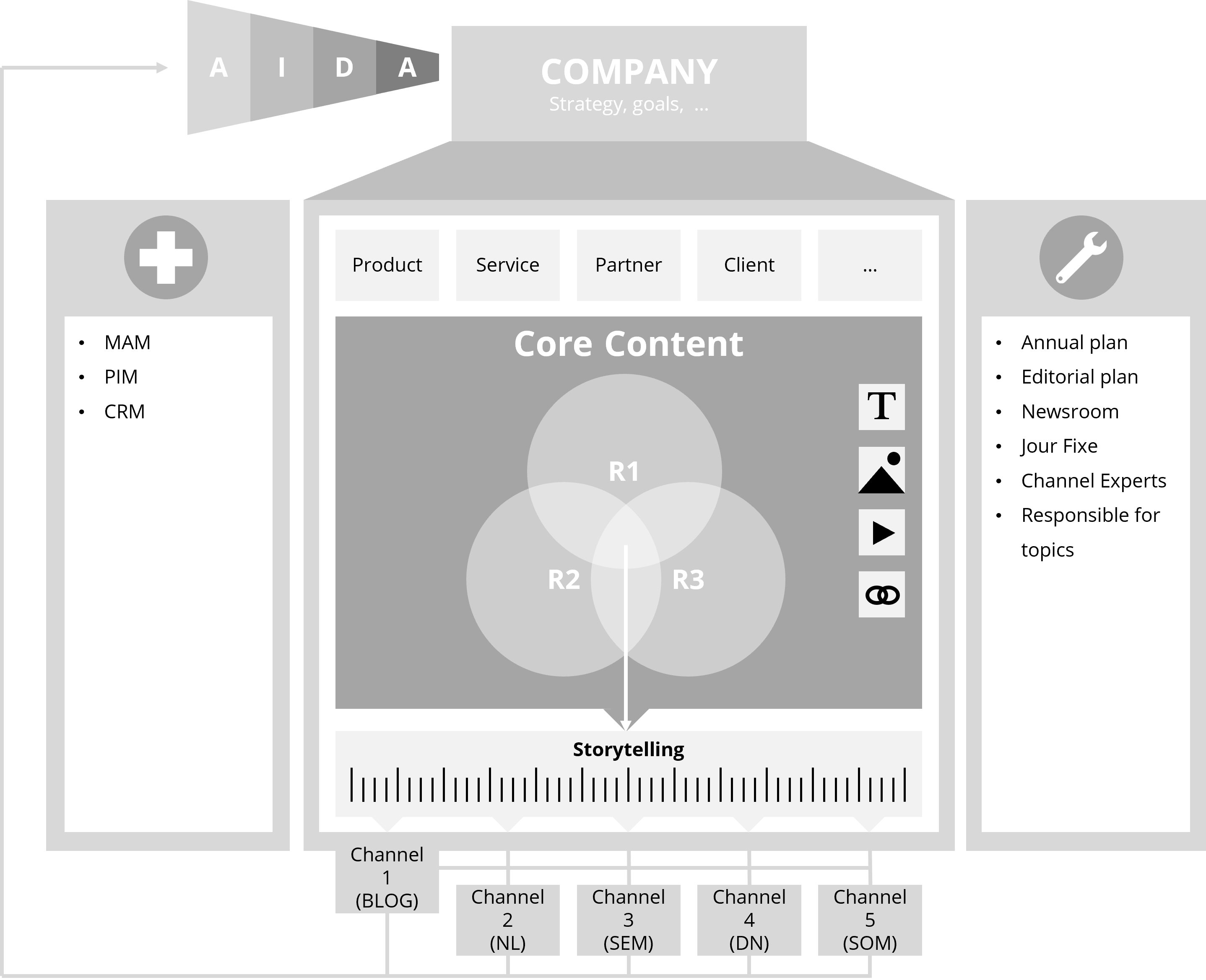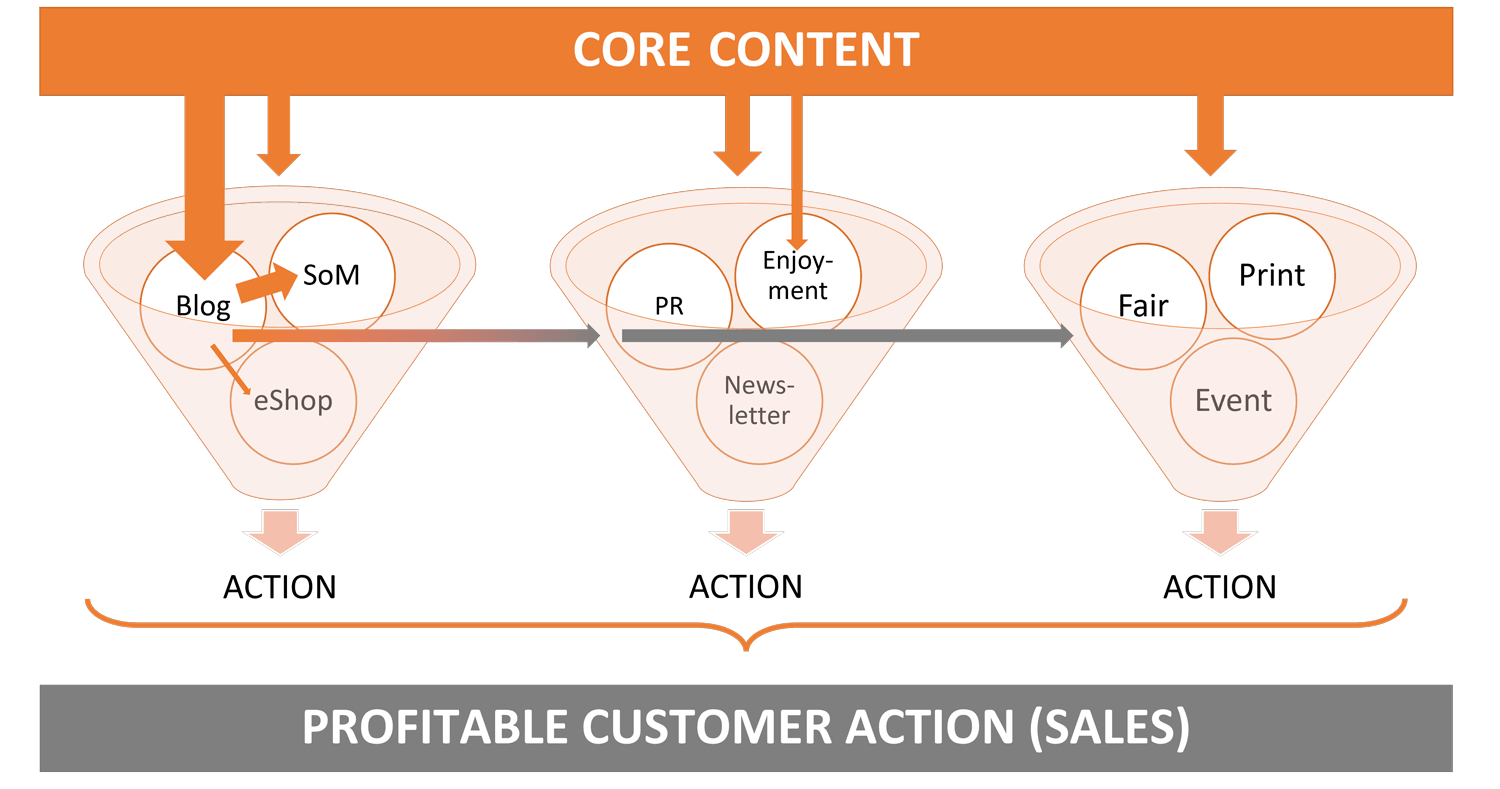Arguably, content is the most overused, yet often misunderstood term in marketing today. Content marketing isn’t a siloed discipline – it takes a holistic, solution-based approach to drive effective and efficient omnichannel marketing. After all, good content is a long-term investment for the business that ultimately aims to increase profitable customer actions.
Without digital marketing, a company hardly stands a chance in the market. Anyone new to the diverse possibilities and measures for social media marketing, search engine marketing, email marketing or other digital marketing measures will find that every year the number of potential channels to be managed increases. More channels basically means that more effort is necessary to publish content and maintain operations, which greatly increases the burden on marketing teams and budgets. Companies must counter this development with efficiency and effectiveness improvements, otherwise they will be crushed by the additional costs.
Strategic content marketing as an effective solution
Synergies must be better exploited to increase efficiency when communicating simultaneously via many different channels; ideally, without reducing the effectiveness of the measures on the various channels. Crucial to this is content. No matter the channel, everyone needs content. If content is produced in silos per channel, which is often the case, the effort required to produce different content per channel increases. This, in turn, increases the risk of the user journey becoming inconsistent across those different channels, while at the same time the cost of servicing those very channels explodes.
By creating core content for central marketing and communications purposes that overarches the individual channels, businesses can arm specialists and agencies with messaging guidelines that facilitate brand adherence while giving them the freedom to scale content to individual channels.
Peter Erni, Managing Director, Brain & Heart Communications
This is precisely where strategic content marketing pulls the lever. By creating core content for central marketing and communications purposes that overarches the individual channels, businesses can arm specialists and agencies with messaging guidelines that facilitate brand adherence while giving them the freedom to scale content to individual channels.
The benefits and mechanics of a content machine
Content should not be produced as an end in itself. A functioning content machine continuously supplies a company with structured content that can be used for channel-specific measures.
The good news is that most companies already have more than enough content. The problem is that this content is happily discussed among employees during a coffee break, for example, and then forgotten again. The ‘content machine’ diagram below demonstrates how core content can be structured and prepared for marketing and communication teams.

The ‘’content machine“
Evaluate and structure content for omnichannel use
Content about products, services, partners, customers is important. This content is always present in the company as collateral: in presentations, brochures, news, stories from customers, partners, employees, etc. For content to be valuable for corporate communications and marketing, it should meet as many of the following criteria as possible:
- Appropriate: the tone fits the company and the target group
- Useful: it has a clear, specific purpose.
- Reader-oriented: text meets reading requirements and needs.
- Clear: it has clearly structured text written in simple, understandable language.
- Consistent: it uses consistent language, structure, presentation within a post and across posts.
- Concise: It uses clear language and conveys relevant content for the reader
Focus on long-term core content
Good content is a long-term investment. Very often its value does not unfold immediately, but only over months or even years. Such content is almost invariably found at the intersection of the following three relevancies:
- Business relevance: The content pays off in terms of corporate and marketing goals
- Target group relevance: The content provides added value to the target audience and appeals to them.
- Channel relevance: The content is suitable for the selected channels and corresponds to best practice.
The term ‘core content’ describes content that fundamentally ‘sits above’ the various marketing and communication channels. This content has all the necessary building blocks; text, images, videos, and links along with key dates, contacts, etc. This allows channel experts or agencies to independently publish appropriate campaigns or measures on a specific channel and thus jointly pursue the same goals.

Logic behind the principle of ‘core content’.
Distribute content over time with storytelling mechanisms
Depending on the channel, storytelling mechanisms can be used so that the individual parts of core content can be published over days, weeks, months, or sometimes even years. Here, it is important to know the strengths and weaknesses, idiosyncrasies and sensitivities of a channel precisely and to keep an eye on the user journey.
Basically, content should be inherited from long-lived channels to feed short-lived channels. For example, a post on a website can be broken down into five social media posts, all of which get published and promoted in a staggered manner on Facebook and three of which get published and promoted on Instagram.
The blog as the lead content channel
Blogs were originally chronologically reversed lists of website addresses. The most recent entry was always at the top, and with each additional entry, the value of a blog as a directory increased. Today, blogs are the technical foundation for web magazines, news sections, media sections or entire websites. This is why blogs are ideal hubs for dynamic and relevant content. Ideally, the content increases the credibility of a company in its core topics and gradually helps it to become an opinion leader. Likewise, owing to the possibility of diving deep into the subject matter, blogs are perfectly suited to better position the company’s site in the field of SEO.
Amplification with social media ads, email marketing and Google Ads
A blog may have many advantages, but like the website itself or an online store, it is per se a “pull medium”: it attracts customers, but it does not proactively motivate or inform them. Here it is necessary to resort to channels with a “push character”: if the company publishes the content as exciting teasers on social media or in a newsletter, it draws further target groups back to the website.
Looking ahead
Anyone who does not invest in their digital marketing and omnichannel marketing today will find it increasingly difficult to reach their customers in the future. Switching to a strategic content approach changes processes in companies breaks down silos and can significantly improve the way communication is done.

